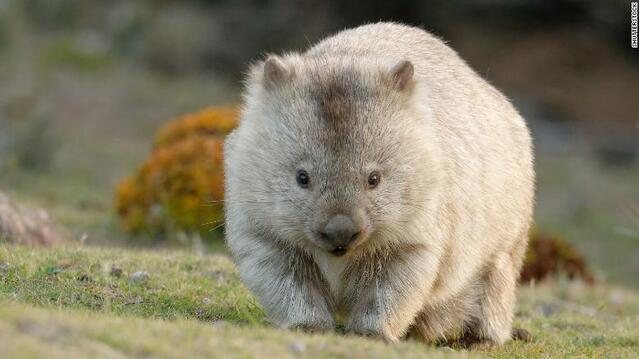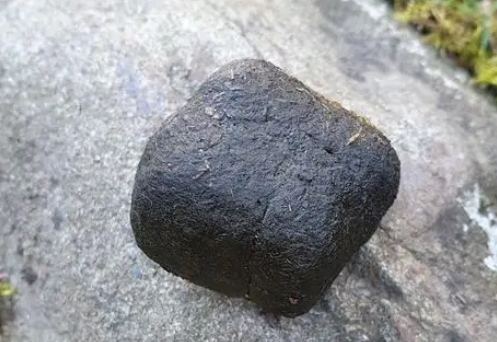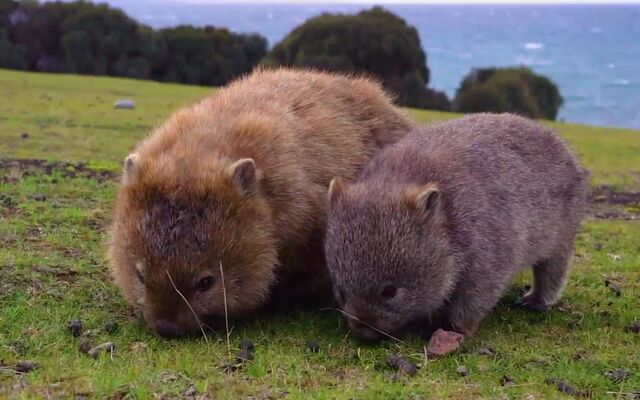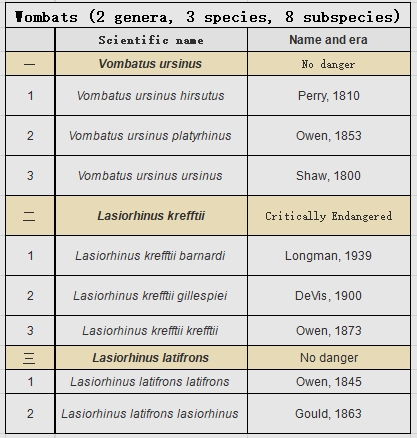Wombat
IUCN
LCBasic Information
Scientific classification
- name:Wombat
- Scientific Name:Phascolomidae
- Outline:Rodents
- Family:Vombatidae Vombatoidea Diprotodontia
Vital signs
- length:70-110cm
- Weight:20-35kg
- lifetime:15-20years
Feature
All its teeth have no roots and grow throughout its life. Its tail is degenerate and its pouch opens backwards with a pair of nipples inside. It is the only creature on Earth that poops in a square shape. The buttocks of "Real Steel" are as hard as rock and form a defensive barrier.
Distribution and Habitat
Wombats are endemic to southeastern Australia. From southeast Queensland to the greater southeastern Australian mainland and Flinders Island and Tasmania. In the forests, hills and coasts of Oceania. Inhabits forests, mountains, wilderness and occasionally appears near farmland.
Appearance
A mammal of the family Wombatidae in the order Diprotodon. It is stout and has a pouch on its abdomen that opens backwards. Its eyes and ears are relatively small, and its body is short and stocky. Wombats have strong claws, a degenerate tail, and coarse gray-brown fur. These features make wombats look slightly like bears but smaller than bears.
Details

Wombats, or Phascolomidae, are marsupials in Australia. They belong to the order Diprotodon, with short legs and well-developed muscles, a body length of about 1 meter, and a very short tail. They live in forests, mountains and heathland in southeastern Australia and Tasmania. The body length ranges from 70 to 110 cm; it weighs 20-35 kg. Males are usually slightly heavier than females. The life span of wild wombats is 15 years, and can reach 20 years in captivity.
Morphological characteristics
Wombats look a bit like bears, but are smaller than bears. The body length is 70-110 cm and the weight is 20-35 kg. The female wombat has a backward-opening pouch on its abdomen, which contains two nipples for the cubs to suck, and the pouch opens backwards. The eyes and ears are small, and the body is short and stout, which can be called "short stature". The wombat's skull is slightly flat, with a round nose and a relatively short nose and face. All teeth have no roots, grow throughout life, and are hard enough to crush stones; the tail is degenerate. The pouch opens backwards and contains a pair of nipples. The limbs are short and powerful, with 5 toes on the front feet, wide and with long claws, and the 3rd and 4th toes on the hind feet are merged. The claws are strong and sharp, like a knife. The tail is degenerate, leaving only traces. The fur is coarse and gray-brown.
The fur color of wombats varies, generally ranging from sandy to brown, or gray to black.
Habitat
Wombats live in open forests, hills and coasts suitable for burrowing in temperate regions. The altitude is about 0-1800 meters.
Living habits
Wombats live in burrows and dig nests with their rodent-like teeth and strong claws. They are very good at digging holes, and the caves they live in are relatively large. Generally, the cave can be up to 10 meters deep and 60 centimeters wide. The end of the cave is the bedroom, with grass and bark as bedding.
Wombats like to be independent and sometimes live in groups of 2-3. They are nocturnal animals, active mainly at dawn, dusk and night. They hide in caves and sleep during the day, but still come out to feed in the cool or dark daytime. They are not easy to see animals, but evidence of them can be seen wherever they go. They are herbivorous, mainly eating grass, sedges, herbs, bark and roots. Their incisors are a bit like rodents, which can be used to bite rough trees or dig caves. Like other herbivorous animals, there is a large longitudinal fissure between their incisors and cheek teeth. Wombats have a very slow metabolism, small eyes and ears, and a short and stout body. It takes about 14 days to complete digestion, which helps them live in a dry environment. Their feces are square. They usually move very slowly, but when they encounter danger, they can escape at a speed of up to 40 kilometers per hour and maintain it for up to 90 seconds. Wombats will protect the territory centered on their nests and are aggressive to intruders. The Tasmanian wombat has a territory of up to 23 hectares, while the hairy-nosed wombat has a territory of no more than 4 hectares.

When attacked, the wombat will exert great resistance. For example, when it is attacked by a predator underground, it will destroy the underground tunnel, suffocating the predator. Its main defense is a cartilaginous structure at the back of its body, together with a short tail, which can prevent predators from attacking its tail when escaping into the tunnel.
Wombats are herbivores. Like most herbivores, wombats' diet includes shrubs, trees, fungi, bark, mosses, leaves and marsh plants, especially perennial grasses. In the dry season, they will also eat withered grass roots. An adult wombat can consume about 2-3 kilograms of food per day.
Although it has a round anus like all other mammals, the hairy-nosed wombat's poop is not a ball, a spiral or a messy pile. They are the only creatures on earth that poop in a square shape. The large intestine of a wombat has special areas where the muscles contract differently from other animals. These special areas can shape the poop into a square shape. Square poop is not easy to roll on irregular terrain, so it can be used to mark territory.

The wombat's buttocks are really "hard stuff". Although the wombat gives people a soft feeling as a whole, its buttocks are actually as hard as stone. It is said that the wombat's buttocks have layer after layer of protective structure, and the outermost cortex is nearly one centimeter thick! Under this thick skin, there is a thick layer of cartilage supporting the entire buttocks. This structure allows the wombat to resist the opponent's claws and fangs when it encounters an attack from a natural enemy. It is simply the "iron fist" of the animal world! When in danger, they will quickly flee back to the vicinity of their cave and take a defensive posture. They will not hide directly in the cave, but leave their buttocks outside the cave entrance as a solid barrier.
Distribution range
The wombat is a species unique to southeastern Australia. From southeastern Queensland to the southeastern Australian mainland, as well as Flinders Island and Tasmania. In the forests, hills and coasts of Oceania. Inhabits forests, mountains, wilderness, and occasionally appears near farmland.
Reproduction method
Male attracts females through scent marking, voice and body language. Males will clash for mating rights and territory.
Wombats are adapted to jumping life and herbivorous. Because of their rumination-like digestion method, they can occupy areas that are disadvantageous to other large mammals. They also have special adaptations in reproduction: females will give birth to a baby wombat in the spring after a gestation period of 26-28 days. They have a well-developed pouch, and after the female has a baby in the pouch, she can protect the baby wombat for 6-7 months. They can still mate and conceive, but the fertilized egg stops developing at the 100-cell stage; if the baby in the pouch dies, the embryo continues to develop; a second baby can be born a few weeks later.
They breed more in summer, with a gestation period of 1 month and 1 baby per litter. Newborn cubs are about 2 cm long and weigh about 2 grams. Wombats are weaned 15 months after birth and become sexually mature at 2-3 years old. The life span is generally about 15 years, and there are also records of wombats living for more than 20 years. The life span of wild wombats is usually 12-15 years.
Wombats are one of the few marsupials whose pouches open backwards, which can prevent soil from running into the pouches and affecting the baby wombats when digging holes.
Wombats in captivity can be very tame. Because wombats are cute, people tend to lack sufficient vigilance, and wombats may be aggressive when they are angry or upset. The weight of a wombat can knock down an average-sized adult, and its sharp teeth and claws can cause damage. A wombat's bite can bite through pants, thick wool socks and rubber boots, and cause a 2 cm deep wound.

In 2017, Patrick passed away accompanied by staff from the Ballarat Wildlife Park at the age of 31, equivalent to 130 years old in human years. On January 31, 2022, the Guinness World Records certified the world's oldest wombat[9] as Wine (translated as red wine) from the Satsukiyama Zoo in Ikeda City, Osaka Prefecture, Japan.
There are currently three species of wombats, namely the Tasmanian wombat, the Queensland hairy-nosed wombat and the South Australian hairy-nosed wombat.
The Tasmanian wombat and the South Australian hairy-nosed wombat are classified as "least concern" species by the Red List of the World Conservation Union (IUCN) due to their wide distribution range and stable population.
The Queensland hairy-nosed wombat, however, has seen a sharp decline in population due to threats such as habitat destruction and predation by alien species, and is classified as "critically endangered" by the Red List of the World Conservation Union (IUCN).
The South Australian hairy-nosed wombat has a wide distribution range and is not close to the vulnerable and endangered critical value standard for species survival (distribution area or fluctuation range less than 20,000 square kilometers, habitat quality, population size, and distribution area fragmentation). The population trend is stable, so it is evaluated as a species with no survival crisis.
Wombats have been found in Australia 20 million years ago, but it was not until July 1797 that a European merchant ship was wrecked in Australia's Bass Strait and the sailors on the ship fled to a nearby island. They saw this animal for the first time. It is now listed in the IUCN Red List of Threatened Species ver 3.1. One of them is critically endangered (CR) and one is near threatened (NT).








